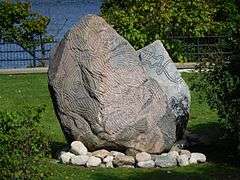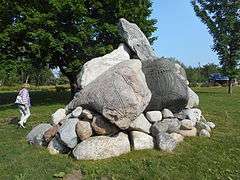Bill Vazan
| Bill Vazan | |
|---|---|
| Born |
1933 Toronto, Ontario |
| Nationality | Canadian |
| Education |
Ontario College of Art École des beaux-arts |
| Known for | artist land art creations, sculpture, painting and photography |
Bill Vazan is a Canadian artist, born in Toronto, Ontario in 1933. He studied Fine Arts at the Ontario College of Art in Toronto, and at the École des beaux-arts in Paris. In 1970 he graduated with a B.A. from Sir George Williams University, now Concordia University, in Montreal, Quebec. He currently lives and works in Montreal. Since 1982 he has taught at the Université du Québec à Montréal. Vazan is internationally known for his land art creations, sculpture, painting and photography. His work has been widely exhibited in North America and abroad.[1] He was made a member of the Royal Canadian Academy of Arts.[2]
Bill Vazan has described himself as "someone who is by nature neurotic, compulsive and obsessive".[3] Starting in the late 1960s, he has made journeys in Montreal and Toronto, and later across Canada and around the world, documenting the journeys in sequences of photographs, maps and notes. The pictures are constrained by a self-imposed protocol such as recording every bus stop or street intersection from exactly the same spatial direction without regard to lighting or composition. The work consists of the line of photographs in the itinerary rather than the individual images. In his projects Canada Line (1969–1970), Worldline (1969–1971) and Intercommunication Lines (1968/2002), Vazan used lines of black tape on the ground to virtually link the locations, symbolically eliminating distance and time.[3]
Bill Vazan's conceptual and minimalist land art projects of the 1960s and 1970s were often ephemeral, created by chalk lines, arrangements of stones and so on, and now only surviving through photographs, books and videos. He created "Canada in Parentheses" in collaboration with Ian Wallace in August 1969. Working simultaneously, each artist created a crescent-shaped form: Wallace on the west coast and Vazan on the east coast. Vazan created other controversial land art projects on the Plains of Abraham in Quebec City (1979), on the Nazca plains in Peru (1984–86), in Utah and Nevada (1993), in Gotland, Sweden (1997) and in the mountains of Thebes in Egypt (2001). In some of these works, Vazan created quasi-mythical sculptures, including rock engravings that resemble Aztec, Mayan or Celtic art.[4]
Bill Vazan considers that nature and humanity are profoundly linked. His work investigates the human-cosmos relationship. In these works, what is important is not what is seen but what is unseen and unknown - the "cosmological shadows".[5]
-
Story Rock, 1986 -

Black Nest, 1991 -

Mirages, 2002 -
Vortexit II, 2009
Solo exhibitions
Bill Vazan has exhibited in numerous group exhibitions, and in the following solo exhibitions:[6]
- 2005 Cosmological Shadows Musée régional de la Côte Nord, Sept-Îles, Quebec
- 2004 Cosmological Shadows Nickle Arts Museum, University of Calgary, Calgary
- 2004 Cosmological Shadows Centre d'exposition de l'Université de Montréal, Montreal
- 2003 Cosmological Shadows Canadian Museum of Contemporary Photography, Ottawa
- 2002 Surface Centre des arts contemporains du Québec à Montréal, Montreal
- 2002 Soundings From The Water Planet, (selection) Deleon White Gallery, Toronto, Ontario.
- 2002 Soundings From The Water Planet. Surface CACQM, Montreal, Quebec.
- 2001 Cosmological Shadows Musée national des beaux-arts du Québec (Expo. Itinérante)
- 1999 Jumpgates 2000 Art Gallery of Peterborough, Ontario.
- 1997 Complicité: Cambodge, 1997 Espace 502, Montreal, Quebec.
- 1994 Regard sur l'œuvre photographique 1981-1994; De l'autre coté du miroir Musée d'art de Joliette. Joliette, Quebec.
- 1994 Sculpture, Paintings and Photos Galerie Dresdnere, Toronto, Ontario.
- 1993 Photowrite Kibbutz Art Gallery, Tel-Aviv, Israel.
- 1992 A Cosmic Dance Agnes Etherington Art Centre, Queen's University, Kingston, Ontario.
- 1989 Unfolding & Heaping, 49th Parallel Canadian Contemporary Art Centre, New York City, USA.
- 1989 Recent Works Eye-Level Gallery, Halifax, Nova Scotia.
- 1989 Mind Frames White Water Gallery, North Bay Firefields, North Bay, Ontario.
- 1989 Mind Frames Struts Gallery, Sackville, New Brunswick
- 1981 Mind Frames - Recent Land and Photoworks Winnipeg Art Gallery; Manitoba.
- 1981 Mind Frames Norman Mackenzie Art Gallery, Regina, Saskatchewan.
- 1981 Mind Frames Art Gallery of Windsor, Ontario.
- 1980 Suites photographiques récentes et œuvres sur le terrain Musée d'art contemporain de Montréal, Montreal, Quebec. (exposition itinérante)
- 1979 œuvres et documentation photographique La chambre blanche,[7] Quebec City, Quebec.
- 1977 Visual Spheres: Photo Scannings Galerie Gilles Gheerbrant, Montreal, Quebec.
- 1977 œuvres planétaires Galerie Shandar, Paris, France.
- 1976 Paris Scannings International Cultural Centre, Antwerp, Belgium
- 1975 Obras recientes Centro de arte y comunicacion, Buenos Aires
- 1975 Obras recientes Gilles Gheerbrant, Montreal, Quebec.
- 1975 Trajectoires solaires Galerie d'art de l'Université de Sherbrooke, Quebec.
- 1974 Contacts Musée d'art contemporain, Montréal, Quebec.
- 1974 Champs de Force Mezzanine Gallery, Nova Scotia College of Art, Halifax.
- 1970 Maps & Movings' A Space, Toronto, Ontario.
- 1969 Taped Sculpture Court Art Gallery of Ontario, Toronto, Ontario.
- 1968 1 + 2 + 3 Galerie Libre, Montreal, Quebec.
Bibliography
- Foreword (2004), Art nature dialogues interviews with environmental artists. P117ff, Albany: State University of New York Press, ISBN 0-7914-6194-7
- Grande, John K (1998), Intertwining : landscape, technology, issues, artists. P42ff, Montréal: Black Rose, ISBN 1-55164-110-0
- Grande, John K (1996), Bill Vazan : jumpgates, an overview of photoworks, 1981-1995, Peterborough, Ont.: Art Gallery of Peterborough, ISBN 1-896809-01-4
- Campbell, James D (1993), Bill Vazan : a cosmic dance, thunderstones, wererocks and shamanic drawings, 1987-1992, Kingston, Ont.: Agnes Etherington Art Centre, ISBN 0-88911-547-8
- Vazan, Danièle Photographie (1987), Bill Vazan : landschemes & waterscapes : œuvres récentes 1982-987 : 12 mai - 11 juin, 1987, Centre Saidye Bronfman, Montreal, Montréal: Centre Saidye Bronfman, ISBN 0-920473-12-1
- Vazan, Bill (1985), Bill Vazan, ghostings : early projects and drawings : premiers projets et dessins, S.l.: Artexte, ISBN 0-9690558-4-6
- 1974. Conceptual Art: Transformation of Natural and of Cultural Environments W Vazan, P Heyer (Leonardo)
References
- ↑ "Meet the Artist: Bill Vazan" Cybermuse. Retrieved 3 March 2009.
- ↑ "Members since 1880". Royal Canadian Academy of Arts. Archived from the original on 26 May 2011. Retrieved 11 September 2013.
- 1 2 "Walking Into the Vanishing Point: Conceptual Works of Bill Vazan" Vox. Retrieved 3 March 2009.
- ↑ "A Conversation with Bill Vazan: Cosmological Shadows" Sculpture.org. Retrieved 3 March 2009.
- ↑ "Bill Vazan: Cosmological Shadows" Archived May 5, 2009, at the Wayback Machine. Kelowna Art Gallery. Retrieved 3 March 2009.
- ↑ "Bill Vazan" York University Fine Arts. Retrieved 3 March 2009.
- ↑ La Chambre Blanche website Retrieved 4 March 2009.